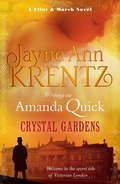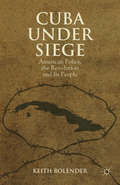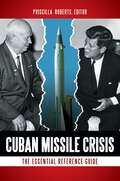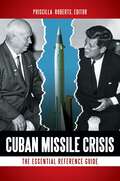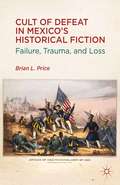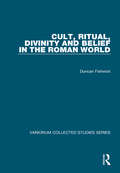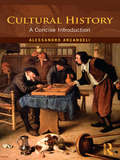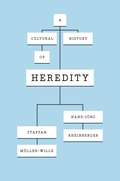- Table View
- List View
Crystal Gardens: Number 1 in series (Ladies of Lantern Street #1)
by Amanda QuickWelcome to the sensational new Ladies of Lantern Streetseries by Amanda Quick, where the lives of the Victorian gentry are filled with secrets - and secret powers . . .Novelist and professional companion Evangeline Ames has rented a cottage on the outskirts of Little Dixby, far from the London streets where she was recently attacked. Fascinated by the paranormal energy of nearby Crystal Gardens, she instinctively goes there for safety where she meets Lucas Sebastian.Lucas and Evangeline immediately sense each other's psychic talents, as well as their mutual desire. But who wants Evangeline dead? With Evangeline's skill for detection, and Lucas's sense of the criminal mind, they soon discover that they share a common enemy. And as the dangerous energy emanating from Crystal Gardens grows stronger, they realise that to survive they must unearth what has been buried for too long.
Cuba Under Siege: American Policy, the Revolution and Its People
by K. BolenderFor more than 50 years America's unrelenting hostility toward the Cuban Revolution has resulted in the development of a siege mentality among island leadership and its citizens. In a vibrant new look at Cuban-American relations, Keith Bolender analyzes the effects this has had on economic, cultural, and political life.
Cuban Identity and the Angolan Experience (New Directions in Latino American Cultures)
by C. PetersExploring the cultural politics of Cuba's epic military engagement in the Angolan civil war, this book narrates the transformation of Cuban national identity from Latin African to Caribbean through the experience of internationalism in Angola.
Cuban Missile Crisis: The Essential Reference Guide
by Priscilla RobertsDrawing on revealing new research, this richly informative volume is the definitive concise introduction to the crisis that took the world to the brink of nuclear war.Cuban Missile Crisis: The Essential Reference Guide captures the historical context, the minute-by-minute drama, and the profound repercussions of the "Missiles of October" confrontation that brought the very real threat of nuclear attack to the United States' doorstep. Coinciding with the 50th anniversary of the crisis, it takes full advantage of recently opened Soviet archives as well as interviews with key Russian, Cuban, and U.S. officials to explore the event as it played out in Moscow, Havana, Washington, and other locations around the world.Cuban Missile Crisis contains an introductory essay by the author and alphabetically organized reference entries contributed by leading Cold War researchers. The book also includes an exceptionally comprehensive bibliography. Together, these resources give readers everything they need to understand the escalating tensions that led to the crisis as well as the intense diplomacy that resolved it, including new information about the back-channel negotiations between Robert Kennedy and Soviet ambassador Anatoly Dobrynin.
Cuban Missile Crisis: The Essential Reference Guide
by Priscilla RobertsDrawing on revealing new research, this richly informative volume is the definitive concise introduction to the crisis that took the world to the brink of nuclear war.Cuban Missile Crisis: The Essential Reference Guide captures the historical context, the minute-by-minute drama, and the profound repercussions of the "Missiles of October" confrontation that brought the very real threat of nuclear attack to the United States' doorstep. Coinciding with the 50th anniversary of the crisis, it takes full advantage of recently opened Soviet archives as well as interviews with key Russian, Cuban, and U.S. officials to explore the event as it played out in Moscow, Havana, Washington, and other locations around the world.Cuban Missile Crisis contains an introductory essay by the author and alphabetically organized reference entries contributed by leading Cold War researchers. The book also includes an exceptionally comprehensive bibliography. Together, these resources give readers everything they need to understand the escalating tensions that led to the crisis as well as the intense diplomacy that resolved it, including new information about the back-channel negotiations between Robert Kennedy and Soviet ambassador Anatoly Dobrynin.
The Cuban Missile Crisis in American Memory: Myths versus Reality (Stanford Nuclear Age Series)
by Sheldon M. SternThis book exposes the misconceptions, half-truths, and outright lies that have shaped the still dominant but largely mythical version of what happened in the White House during those harrowing two weeks of secret Cuban missile crisis deliberations. A half-century after the event it is surely time to demonstrate, once and for all, that RFK's Thirteen Days and the personal memoirs of other ExComm members cannot be taken seriously as historically accurate accounts of the ExComm meetings.
Cult of Defeat in Mexico’s Historical Fiction: Failure, Trauma, and Loss
by B. PriceCult of Defeat in Mexico's Historical Fiction: Failure, Trauma, and Loss examines recent Mexican historical novels that highlight the mistakes of the nineteenth century for the purpose of responding to present crises.
The Cult of Saint Katherine of Alexandria in Late-Medieval Nuremberg: Saint and the City
by Anne SimonKatherine of Alexandria was a major object of devotion within medieval Europe, ranking second only to the Virgin Mary in the canon of female saints. Yet despite her undoubted importance, relatively little is known about the significance and function of her cult within the German-speaking territories that stood at the heart of Europe. Anne Simon's study adds a welcome new interdisciplinary perspective to the study of Saint Katherine and the wider ecclesiastical landscape of a medieval Europe poised on the edge of religious change. Taking as a case study the wealthy and politically influential merchant city of Nuremberg, this book draws on a wide variety of textual and visual sources to explore interrelated themes: the shaping of urban space through the cult of Saint Katherine; her role in the moulding and advertising patrician identity and alliances through cultural patronage; and patrician use of the saint to showcase the city's political, economic, cultural and religious importance at the heart of the Holy Roman Empire. Further , the book reveals the construction of exemplarity in Saint Katherine's legend and miracles and their resonance within the context of the city and the Dominican Convent of Saint Katherine, whose nuns came from the same status-aware, confident patrician elite that so loyally supported successive Emperors. Filling a significant gap in current research, the work has much to offer scholars of medieval history, hagiography, art history, German studies, cultural and urban studies. Hence it not only expands our understanding of Saint Katherine's importance in German-speaking territories, but also adds to the picture of her cult in its European perspective.
The Cult of Saint Katherine of Alexandria in Late-Medieval Nuremberg: Saint and the City
by Anne SimonKatherine of Alexandria was a major object of devotion within medieval Europe, ranking second only to the Virgin Mary in the canon of female saints. Yet despite her undoubted importance, relatively little is known about the significance and function of her cult within the German-speaking territories that stood at the heart of Europe. Anne Simon's study adds a welcome new interdisciplinary perspective to the study of Saint Katherine and the wider ecclesiastical landscape of a medieval Europe poised on the edge of religious change. Taking as a case study the wealthy and politically influential merchant city of Nuremberg, this book draws on a wide variety of textual and visual sources to explore interrelated themes: the shaping of urban space through the cult of Saint Katherine; her role in the moulding and advertising patrician identity and alliances through cultural patronage; and patrician use of the saint to showcase the city's political, economic, cultural and religious importance at the heart of the Holy Roman Empire. Further , the book reveals the construction of exemplarity in Saint Katherine's legend and miracles and their resonance within the context of the city and the Dominican Convent of Saint Katherine, whose nuns came from the same status-aware, confident patrician elite that so loyally supported successive Emperors. Filling a significant gap in current research, the work has much to offer scholars of medieval history, hagiography, art history, German studies, cultural and urban studies. Hence it not only expands our understanding of Saint Katherine's importance in German-speaking territories, but also adds to the picture of her cult in its European perspective.
Cult, Ritual, Divinity and Belief in the Roman World (Variorum Collected Studies)
by Duncan FishwickThe papers assembled in this selection of studies range in subject matter from early Judaic magic to an inscribed monument of the Neo-Classical period. The principal emphasis of the collection is nevertheless on religious developments under the High Roman Empire: problems arising from the interpretation of oriental cults imported from the Hellenistic East but primarily the development of imperial cult, the one universal religion of the empire before the coming of Christianity. The essays divide into five categories: Divinity and Power; The Imperial Numen; The Imperial Cult: Review and Discussion; Rituals and Ceremonies; Ainigmata. The titles of the individual articles speak for themselves but readers may also find the preface of interest in so far as it sets out the author's ideas on the controversial nature of the emperor's divinity. While this is a topic deserving of a book in its own right, the preface together with the points raised by individual studies within the overall framework may go some way to repairing this defficiency.
Cult, Ritual, Divinity and Belief in the Roman World (Variorum Collected Studies)
by Duncan FishwickThe papers assembled in this selection of studies range in subject matter from early Judaic magic to an inscribed monument of the Neo-Classical period. The principal emphasis of the collection is nevertheless on religious developments under the High Roman Empire: problems arising from the interpretation of oriental cults imported from the Hellenistic East but primarily the development of imperial cult, the one universal religion of the empire before the coming of Christianity. The essays divide into five categories: Divinity and Power; The Imperial Numen; The Imperial Cult: Review and Discussion; Rituals and Ceremonies; Ainigmata. The titles of the individual articles speak for themselves but readers may also find the preface of interest in so far as it sets out the author's ideas on the controversial nature of the emperor's divinity. While this is a topic deserving of a book in its own right, the preface together with the points raised by individual studies within the overall framework may go some way to repairing this defficiency.
Cultural Afterlives and Screen Adaptations of Classic Literature: Wuthering Heights and Company
by H. ShacharFilm and television adaptations of classic literature have held a longstanding appeal for audiences, an appeal that this book sets out to examine. With a particular focus on Wuthering Heights , the book examines adaptations made from the 1930s to the twenty-first century, providing an understanding of how they help shape our cultural landscape.
Cultural History: A Concise Introduction
by Alessandro ArcangeliThe expression ‘cultural history’ is generally used today to signal a particular approach to history, one which could be applied to any object, and is mainly concerned with the sense men and women from the past gave to the world they lived in. In this introduction to cultural history as a subdiscipline, the reader will find the key steps in the historical development of the field from 1850 to the present. It surveys different ways in which cultural history has been practised, exploring intellectual history, the history of ideas and concepts, of mentalities, of symbols and representations, and of languages and discourses. Cultural History also maps the territory cultural history most effectively enlightens: gender; the family and sexuality; the body; senses and emotions and images; material culture and consumption; the media and communication. Lastly, it includes an appendix of biographies of a number of influential cultural historians. This concise and accessible introduction will be an essential volume for any university student studying cultural history.
Cultural History: A Concise Introduction
by Alessandro ArcangeliThe expression ‘cultural history’ is generally used today to signal a particular approach to history, one which could be applied to any object, and is mainly concerned with the sense men and women from the past gave to the world they lived in. In this introduction to cultural history as a subdiscipline, the reader will find the key steps in the historical development of the field from 1850 to the present. It surveys different ways in which cultural history has been practised, exploring intellectual history, the history of ideas and concepts, of mentalities, of symbols and representations, and of languages and discourses. Cultural History also maps the territory cultural history most effectively enlightens: gender; the family and sexuality; the body; senses and emotions and images; material culture and consumption; the media and communication. Lastly, it includes an appendix of biographies of a number of influential cultural historians. This concise and accessible introduction will be an essential volume for any university student studying cultural history.
A Cultural History of Heredity
by Staffan Müller-Wille Hans-Jörg RheinbergerIt was only around 1800 that heredity began to enter debates among physicians, breeders, and naturalists. Soon thereafter it evolved into one of the most fundamental concepts of biology. Here Staffan Müller-Wille and Hans-Jörg Rheinberger offer a succinct cultural history of the scientific concept of heredity. They outline the dramatic changes the idea has undergone since the early modern period and describe the political and technological developments that brought about these changes. Müller-Wille and Rheinberger begin with an account of premodern theories of generation, showing that these were concerned with the procreation of individuals rather than with hereditary transmission. The authors reveal that when hereditarian thinking first emerged, it did so in a variety of cultural domains, such as politics and law, medicine, natural history, breeding, and anthropology. Müller-Wille and Rheinberger then track theories of heredity from the late nineteenth century—when leading biologists considered it in light of growing societal concerns with race and eugenics—through the rise of classical and molecular genetics in the twentieth century, to today, as researchers apply sophisticated information technologies to understand heredity. What readers come to see from this exquisite history is why it took such a long time for heredity to become a prominent concept in the life sciences and why it gained such overwhelming importance in those sciences and the broader culture over the last two centuries.
A Cultural History of Heredity
by Staffan Müller-Wille Hans-Jörg RheinbergerIt was only around 1800 that heredity began to enter debates among physicians, breeders, and naturalists. Soon thereafter it evolved into one of the most fundamental concepts of biology. Here Staffan Müller-Wille and Hans-Jörg Rheinberger offer a succinct cultural history of the scientific concept of heredity. They outline the dramatic changes the idea has undergone since the early modern period and describe the political and technological developments that brought about these changes. Müller-Wille and Rheinberger begin with an account of premodern theories of generation, showing that these were concerned with the procreation of individuals rather than with hereditary transmission. The authors reveal that when hereditarian thinking first emerged, it did so in a variety of cultural domains, such as politics and law, medicine, natural history, breeding, and anthropology. Müller-Wille and Rheinberger then track theories of heredity from the late nineteenth century—when leading biologists considered it in light of growing societal concerns with race and eugenics—through the rise of classical and molecular genetics in the twentieth century, to today, as researchers apply sophisticated information technologies to understand heredity. What readers come to see from this exquisite history is why it took such a long time for heredity to become a prominent concept in the life sciences and why it gained such overwhelming importance in those sciences and the broader culture over the last two centuries.
A Cultural History of Heredity
by Staffan Müller-Wille Hans-Jörg RheinbergerIt was only around 1800 that heredity began to enter debates among physicians, breeders, and naturalists. Soon thereafter it evolved into one of the most fundamental concepts of biology. Here Staffan Müller-Wille and Hans-Jörg Rheinberger offer a succinct cultural history of the scientific concept of heredity. They outline the dramatic changes the idea has undergone since the early modern period and describe the political and technological developments that brought about these changes. Müller-Wille and Rheinberger begin with an account of premodern theories of generation, showing that these were concerned with the procreation of individuals rather than with hereditary transmission. The authors reveal that when hereditarian thinking first emerged, it did so in a variety of cultural domains, such as politics and law, medicine, natural history, breeding, and anthropology. Müller-Wille and Rheinberger then track theories of heredity from the late nineteenth century—when leading biologists considered it in light of growing societal concerns with race and eugenics—through the rise of classical and molecular genetics in the twentieth century, to today, as researchers apply sophisticated information technologies to understand heredity. What readers come to see from this exquisite history is why it took such a long time for heredity to become a prominent concept in the life sciences and why it gained such overwhelming importance in those sciences and the broader culture over the last two centuries.
A Cultural History of Heredity
by Staffan Müller-Wille Hans-Jörg RheinbergerIt was only around 1800 that heredity began to enter debates among physicians, breeders, and naturalists. Soon thereafter it evolved into one of the most fundamental concepts of biology. Here Staffan Müller-Wille and Hans-Jörg Rheinberger offer a succinct cultural history of the scientific concept of heredity. They outline the dramatic changes the idea has undergone since the early modern period and describe the political and technological developments that brought about these changes. Müller-Wille and Rheinberger begin with an account of premodern theories of generation, showing that these were concerned with the procreation of individuals rather than with hereditary transmission. The authors reveal that when hereditarian thinking first emerged, it did so in a variety of cultural domains, such as politics and law, medicine, natural history, breeding, and anthropology. Müller-Wille and Rheinberger then track theories of heredity from the late nineteenth century—when leading biologists considered it in light of growing societal concerns with race and eugenics—through the rise of classical and molecular genetics in the twentieth century, to today, as researchers apply sophisticated information technologies to understand heredity. What readers come to see from this exquisite history is why it took such a long time for heredity to become a prominent concept in the life sciences and why it gained such overwhelming importance in those sciences and the broader culture over the last two centuries.
A Cultural History of Heredity
by Staffan Müller-Wille Hans-Jörg RheinbergerIt was only around 1800 that heredity began to enter debates among physicians, breeders, and naturalists. Soon thereafter it evolved into one of the most fundamental concepts of biology. Here Staffan Müller-Wille and Hans-Jörg Rheinberger offer a succinct cultural history of the scientific concept of heredity. They outline the dramatic changes the idea has undergone since the early modern period and describe the political and technological developments that brought about these changes. Müller-Wille and Rheinberger begin with an account of premodern theories of generation, showing that these were concerned with the procreation of individuals rather than with hereditary transmission. The authors reveal that when hereditarian thinking first emerged, it did so in a variety of cultural domains, such as politics and law, medicine, natural history, breeding, and anthropology. Müller-Wille and Rheinberger then track theories of heredity from the late nineteenth century—when leading biologists considered it in light of growing societal concerns with race and eugenics—through the rise of classical and molecular genetics in the twentieth century, to today, as researchers apply sophisticated information technologies to understand heredity. What readers come to see from this exquisite history is why it took such a long time for heredity to become a prominent concept in the life sciences and why it gained such overwhelming importance in those sciences and the broader culture over the last two centuries.
A Cultural History of Heredity
by Staffan Müller-Wille Hans-Jörg RheinbergerIt was only around 1800 that heredity began to enter debates among physicians, breeders, and naturalists. Soon thereafter it evolved into one of the most fundamental concepts of biology. Here Staffan Müller-Wille and Hans-Jörg Rheinberger offer a succinct cultural history of the scientific concept of heredity. They outline the dramatic changes the idea has undergone since the early modern period and describe the political and technological developments that brought about these changes. Müller-Wille and Rheinberger begin with an account of premodern theories of generation, showing that these were concerned with the procreation of individuals rather than with hereditary transmission. The authors reveal that when hereditarian thinking first emerged, it did so in a variety of cultural domains, such as politics and law, medicine, natural history, breeding, and anthropology. Müller-Wille and Rheinberger then track theories of heredity from the late nineteenth century—when leading biologists considered it in light of growing societal concerns with race and eugenics—through the rise of classical and molecular genetics in the twentieth century, to today, as researchers apply sophisticated information technologies to understand heredity. What readers come to see from this exquisite history is why it took such a long time for heredity to become a prominent concept in the life sciences and why it gained such overwhelming importance in those sciences and the broader culture over the last two centuries.
A Cultural History of Heredity
by Hans-Jörg Rheinberger Staffan Müller-WilleIt was only around 1800 that heredity began to enter debates among physicians, breeders, and naturalists. Soon thereafter it evolved into one of the most fundamental concepts of biology. Here Staffan Müller-Wille and Hans-Jörg Rheinberger offer a succinct cultural history of the scientific concept of heredity. They outline the dramatic changes the idea has undergone since the early modern period and describe the political and technological developments that brought about these changes. Müller-Wille and Rheinberger begin with an account of premodern theories of generation, showing that these were concerned with the procreation of individuals rather than with hereditary transmission. The authors reveal that when hereditarian thinking first emerged, it did so in a variety of cultural domains, such as politics and law, medicine, natural history, breeding, and anthropology. Müller-Wille and Rheinberger then track theories of heredity from the late nineteenth century—when leading biologists considered it in light of growing societal concerns with race and eugenics—through the rise of classical and molecular genetics in the twentieth century, to today, as researchers apply sophisticated information technologies to understand heredity. What readers come to see from this exquisite history is why it took such a long time for heredity to become a prominent concept in the life sciences and why it gained such overwhelming importance in those sciences and the broader culture over the last two centuries.
A Cultural History of the Avant-Garde in the Nordic Countries 1900-1925 (PDF)
by Hubert van den Berg Irmeli Hautamäki EtcA Cultural History of the Avant-Garde in the Nordic Countries 1900-1925 is the first publication to deal with the avant-garde in the Nordic countries at the start of the twentieth century. The essays cover a wide range of avant-garde manifestations in arts and culture: literature, the visual arts, painting as well as photography, architecture and design, film, radio, and performing arts like music, theatre and dance. It is the first major historical work to consider the Nordic avant-garde in a transnational perspective which includes all the arts and to discuss the role of the avant-garde not only within the aesthetic field, but in a broader cultural context. It examines the social and cultural context of the avant-garde: its media, its locations, its reception and audiences, the transmissions between Scandinavia and Europe, and its cultural consequences. The essays trace the connections between the avant-garde and the cultural discourses of contemporary currents such as revolutionary socialism, radical nationalism and occultism, and discuss questions of gender, ideology and politics, geographical location and technological innovation. The cultural history thus focuses on the role of the avant-garde in shaping the ideas of cultural modernity in the Nordic countries.
The Cultural Revolution: A Very Short Introduction (Very Short Introductions)
by Richard Curt KrausChina's decade-long Great Proletarian Cultural Revolution shook the politics of China and the world. Even as we approach its fiftieth anniversary, the movement remains so contentious that the Chinese Communist Party still forbids fully open investigation of its origins, development, and conclusion. Drawing upon a vital trove of scholarship, memoirs, and popular culture, this Very Short Introduction illuminates this complex, often obscure, and still controversial movement. Moving beyond the figure of Mao Zedong, Richard Curt Kraus links Beijing's elite politics to broader aspects of society and culture, highlighting many changes in daily life, employment, and the economy. Kraus also situates this very nationalist outburst of Chinese radicalism within a global context, showing that the Cultural Revolution was mirrored in the radical youth movement that swept much of the world, and that had imagined or emotional links to China's red guards. Yet it was also during the Cultural Revolution that China and the United States tempered their long hostility, one of the innovations in this period that sowed the seeds for China's subsequent decades of spectacular economic growth.
The Cultural Role of Architecture: Contemporary and Historical Perspectives
by Paul Emmons Jane Lomholt John Shannon HendrixExploring the ambiguities of how we define the word ‘culture’ in our global society, this book identifies its imprint on architectural ideas. It examines the historical role of the cultural in architectural production and expression, looking at meaning and communication, tracing the formations of cultural identities. Chapters written by international academics in history, theory and philosophy of architecture, examine how different modes of representation throughout history have drawn profound meanings from cultural practices and beliefs. These are as diverse as the designs they inspire and include religious, mythic, poetic, political, and philosophical references.
The Cultural Role of Architecture: Contemporary and Historical Perspectives
by Paul Emmons John Hendrix Jane LomholtExploring the ambiguities of how we define the word ‘culture’ in our global society, this book identifies its imprint on architectural ideas. It examines the historical role of the cultural in architectural production and expression, looking at meaning and communication, tracing the formations of cultural identities. Chapters written by international academics in history, theory and philosophy of architecture, examine how different modes of representation throughout history have drawn profound meanings from cultural practices and beliefs. These are as diverse as the designs they inspire and include religious, mythic, poetic, political, and philosophical references.
